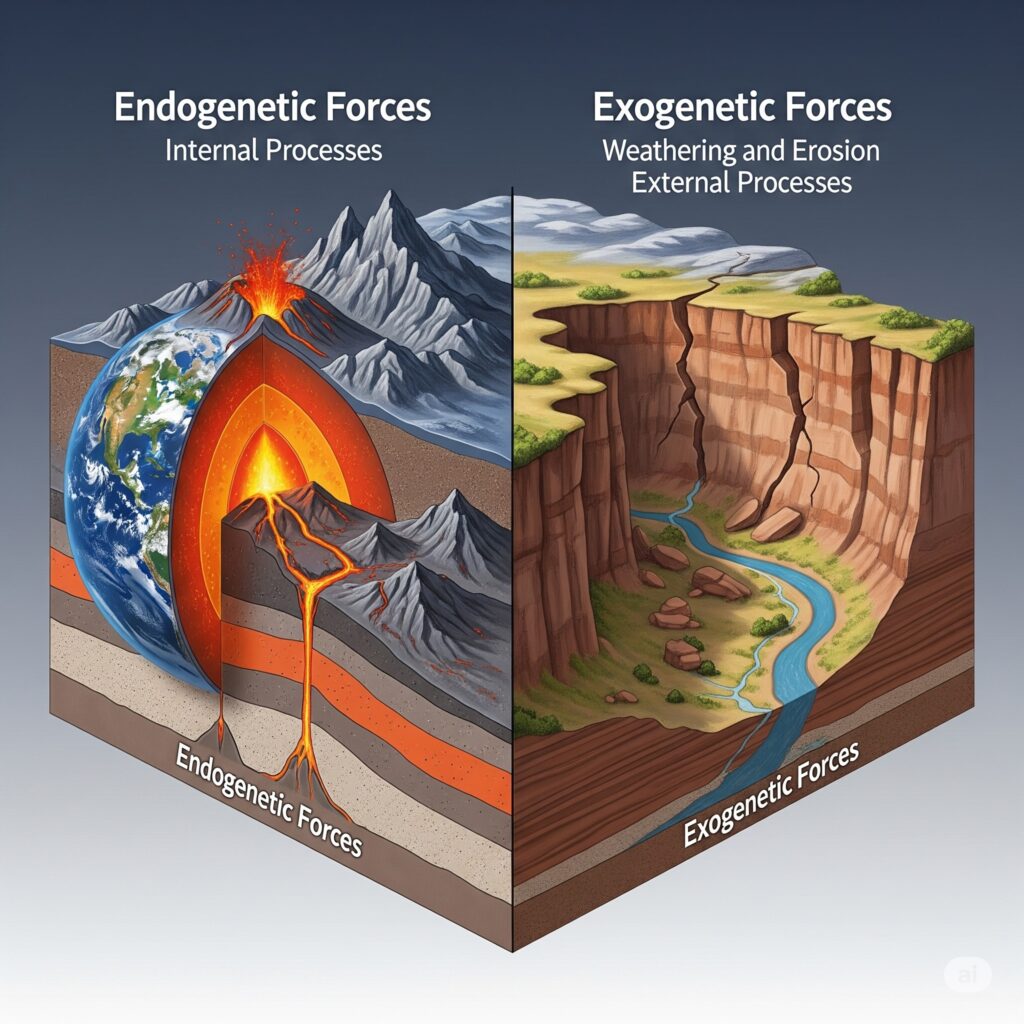The Endogenetic and Exogenetic Forces are constantly shaping our Earth. The Earth is constantly undergoing changes and transformations, some of which are caused by internal processes and others by external forces. These changes help shape the planet and create the geological features we see today. There are two main categories of geological forces that cause these changes: endogenic forces and exogenic forces.

The endogenic forces are mainly land building forces and the exogenic processes are mainly land wearing forces. Exogenic processes can cause existing landforms to be destroyed by weathering and erosional processes, these forces are often called as “destructive forces.” Important exogenic processes include wasting, erosion, deposition, and weathering. The atmosphere, which is influenced by the sun’s primary energy as well as the gradient that tectonic forces create, provides the exogenic forces with their energy. Over the course of hundreds or millions of years, exogenic factors produce changes that are discernible. Examples include winds, rivers, and glaciers etc.
Table of Contents
Endogenic Forces
Endogenetic forces, also known as internal forces, originate from within the Earth’s crust and mantle. These forces are primarily responsible for the creation of landforms through processes such as tectonic activity and volcanic eruptions.
"Endogenetic forces come from within the Earth, fueled by the immense heat and energy in the planet's interior."
Types of endogenetic forces:
Tectonic Activity
This involves the movement and interaction of tectonic plates, which make up the Earth’s lithosphere. Tectonic activity leads to processes like continental drift, the formation of mountain ranges through collision or divergence of plates, and the occurrence of earthquakes along faults.
Volcanic Activity
Volcanic eruptions result from the movement of magma from the Earth’s mantle to the surface. When magma erupts onto the surface, it cools and solidifies, forming volcanic landforms such as mountains, lava plateaus, and volcanic cones.
Exogenic forces
Exogenetic forces are the external forces, that operate on the Earth’s surface due to external factors like weather, climate, and erosion agents. These forces are primarily responsible for modifying and sculpting the landforms created by endogenetic forces.
"Exogenetic forces act on the Earth's surface and are largely driven by the atmosphere and the sun's energy."
Key components of exogenetic forces are:
Weathering
Weathering refers to the breakdown of rocks and minerals on the Earth’s surface due to exposure to atmospheric factors such as rain, wind, temperature changes, and biological activity. It can lead to the disintegration of rocks into smaller particles.
Erosion
Erosion is the transport of weathered materials (sediments) from one place to another by natural agents such as water (rivers, streams, waves), wind, ice (glaciers), and gravity (mass wasting). Erosion gradually wears down landforms and reshapes the Earth’s surface.
Deposition
Deposition occurs when eroded materials settle and accumulate in a new location. This process is responsible for the formation of various landforms such as river deltas, alluvial fans, sand dunes, and sedimentary layers.
Comparison of Endogenetic and Exogenetic Forces
| Feature | Endogenetic Forces | Exogenetic Forces |
|---|---|---|
| Origin | Originate from within the Earth’s interior | Originate from outside the Earth’s surface/atmosphere |
| Source of Energy | Earth’s internal heat (radioactivity, primordial heat, rotational and tidal friction) | Solar energy (drives atmospheric processes), gravity, tectonic gradients |
| Nature of Action | Primarily constructive (land-building) | Primarily destructive (land-wearing) and depositional |
| Movement Type | Can be sudden (e.g., earthquakes, volcanic eruptions) or slow (e.g., mountain building) | Generally slow and continuous processes, but their effects can be observed over shorter or longer timescales |
| Effects | Create major relief features like mountains, plateaus, rift valleys, ocean basins | Wear down existing landforms, create erosional and depositional features like valleys, plains, deltas, sand dunes |
| Processes | Diastrophism (folding, faulting, warping), Volcanism, Earthquakes | Weathering (physical, chemical, biological), Mass Wasting, Erosion, Deposition |
| Examples | Himalayas (fold mountains), Mid-Atlantic Ridge (rift valley), Volcanic eruptions in Indonesia, Earthquakes in Japan | Formation of river valleys, sand dunes in deserts, coastal cliffs, soil erosion, landslides |
| Impact on Relief | Lead to upliftment and creation of irregularities on the Earth’s surface | Lead to degradation (wearing down) and aggradation (filling up) of basins, leveling the surface |
| Visibility of Effects | Sudden effects are immediately visible; slow effects become apparent over geological timeframes | Effects are generally visible over thousands or millions of years, though some, like floods or landslides, can be sudden. |
Both endogenic and exogenic forces are essential for shaping the Earth and creating the geological features we see today. Endogenic forces are more powerful and can have a larger impact on the planet, while exogenic forces tend to have a more gradual effect over time.
Read: Geography